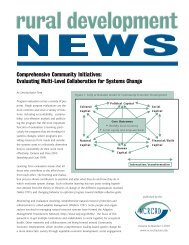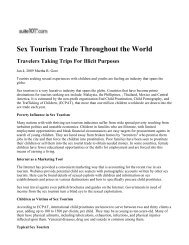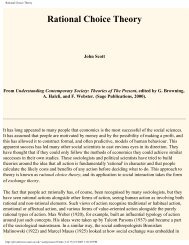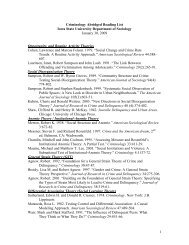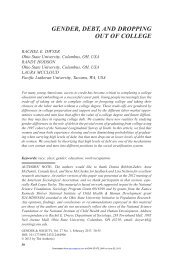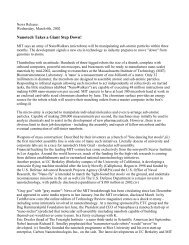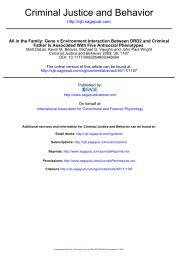Rape and Sexual Assault
Rape and Sexual Assault
Rape and Sexual Assault
You also want an ePaper? Increase the reach of your titles
YUMPU automatically turns print PDFs into web optimized ePapers that Google loves.
<strong>Rape</strong> <strong>and</strong> <strong>Sexual</strong> <strong>Assault</strong>Dean G. Kilpatrick, Ph.D.National Violence Against Women Prevention Research CenterMedical University of South Carolina<strong>Rape</strong> is the most underreported crime in America. Significant changes to improve the treatment ofsexual assault victims have occurred in the last two decades. The impact of reforms, led by thewomen's movement, can be seen in the legal, mental health, medical, <strong>and</strong> victim services arenas.During the 1970s, the first rape crisis center was established. The treatment of victims in thecriminal justice system was questioned, <strong>and</strong> hundreds of laws were passed to protect rape victimsin the courts. Medical protocols have been developed <strong>and</strong> widely accepted. The mental healthimpact of rape is well documented in the literature, <strong>and</strong> the practices of mental health professionalshave improved.Although the treatment of rape victims today is vastly different from three decades ago, manyvictims still do not receive the assistance <strong>and</strong> treatment they need.Statistical OverviewObtaining an accurate measurement of rape <strong>and</strong> other types of sexual assault is a challenge.Determining the scope <strong>and</strong> nature of rape <strong>and</strong> other types of sexual assault depends on how thesecrimes are defined <strong>and</strong> measured. It is important to note that statistics are derived from differentsources employing different practices to gather information.In 1997, there were 96,122 reported forcible rapes. (Federal Bureau of Investigation. (releasedNovember 22, 1998). Crime in the United States, Uniform Crime Reports, 1997, p.26. Washington,DC: U.S. Department of Justice.)An estimated 70 of every 100,000 females in the country were reported rape victims in1997, a decrease 1% from 1996 13% from 1993. (Ibid.)1997 National Crime Victimization Survey, which includes both reported <strong>and</strong> unreportedcrimes, found that despite a decline of 7% in the nation’s crime rate in 1997, rates of rape<strong>and</strong> sexual assault did not decline. (Bureau of Justice Statistics. (1998, December). NationalCrime Victimization Survey. Washington, DC: U.S. Department of Justice.)The National Violence Against Women Survey, the first national study on stalking, foundthat in the 12 months preceding the study, 0.3 percent of all women surveyed experienced acompleted or attempted rape, <strong>and</strong> 1.9 percent experienced a physical assault. (ViolenceAgainst Women Grants Office. (1998, July). Stalking <strong>and</strong> Domestic Violence: Third AnnualReport to Congress Under the Violence Against Women Act, p.7. Washington, DC: U.S.Department of Justice.)The National Women’s Study (NWS), found that approximately 13% of adult women hadbeen victims of completed rape during their lifetime (Kilpatrick, Edmunds, & Seymour,1992; Resnick, Kilpatrick, Dansky, Saunders, & Best, 1993). During the year betweeninterviews, 0.6% of adult women, or an estimated 683,000 women were victims of rape(Kilpatrick et al., 1992). In the two years between the first <strong>and</strong> third interviews, 1.2% of theadult participants in the NWS were raped. The results: an estimated 1.1 million women wereraped in the United States during this two-year period (Kilpatrick, Resnick, Saunders, Best,
1997).Using a definition of rape that includes forced vaginal, oral, <strong>and</strong> anal sex, the NationalViolence Against Women Survey found that 1 of 6 U.S. Women <strong>and</strong> 1 of 33 U.S. men hasexperienced an attempted or completed rape as a child <strong>and</strong>/or adult. According to estimates,approximately 1.5 million women <strong>and</strong> 834,700 men are raped <strong>and</strong>/or physically assaultedannually by an intimate partner in the United States. (Tjaden, P. & Thoennes, N. (1998,November). A Prevalence, Incidence, <strong>and</strong> Consequences of Violence Against Women:Findings From the National Violence Against Women Survey, @ p. 2 & 5. Research in Brief.Washington, DC: National Institute of Justice, U.S. Department of Justice.)In 1996, more than two-thirds of rape/sexual assaults committed in the nation remainedunreported. (Ringel, C. (1997, November). Criminal Victimization in 1996, Changes 1995-1996 with Trends 1993-1996, NCJ-165812, p.3. Washington, DC: Bureau of JusticeStatistics, U.S. Department of Justice.)The National Survey of Adolescents (NSA), a National Institute of Justice funded study ofnational household probability sample of 4,023 adolescents age 12-17, found that 8.1% ofU.S. adolescents had been victims of at least one sexual assault (Kilpatrick & Saunders,1997; Kilpatrick, Acierno, Saunders, Resnick, Best, & Schnurr, 2000). This indicates that anestimated 1.8 million 12 to 17 year olds have been sexually assaultedMore than 52 percent of all rape/sexual assault victims were females younger than 25.(Perkins, C. (1997, September). Age Patterns of Victims of Serious Crimes, NCJ-162031, p.1.Washington, DC: Bureau of Justice Statistics, U.S. Department of Justice.)Women who suffered physical injury in addition to the injury suffered from the rape orsexual assault reported 37% of those crimes, while only 22% of rapes <strong>and</strong> sexual assaultswithout an additional physical injury were reported. (Craven, D. (1994.) A Sex Differences inViolent Victimization, @ NCJ-164508, p.5. Bureau of Justice Statistics, Special Report.Washington, DC: U.S. Department of Justice).IntroductionAlthough rape has occurred throughout history, the birth of the anti-rape movement in the USoccurred only in the early 1970s. In 1972, the first rape crisis centers were established in SanFrancisco, CA (Bay Area Women Against <strong>Rape</strong>) <strong>and</strong> Washington, D.C. These grass roots centersgrew out of the women’s movement. They recognized that rape was an all-too-common part ofwomen’s lives <strong>and</strong> that it had a devastating impact on health <strong>and</strong> freedom. The goals of centerswere to educate society about rape <strong>and</strong> rape-prevention <strong>and</strong> to improve the treatment of victims.In the nearly three decades since its birth, the anti-rape movement has accomplished many of itsgoals. Major accomplishments include:Widespread reform of rape statutes <strong>and</strong> other legislation.Improvements in the way criminal justice officials treat victims.A better underst<strong>and</strong>ing of the scope <strong>and</strong> impact of rape.Improved medical <strong>and</strong> mental health services.Better funding for rape crisis centers <strong>and</strong> others who assist victims.Despite this progress, there is much to be done. The fact that well over a million Americans of allages are raped each year suggests that efforts to prevent rape have not been entirely successful.
Most rape cases go unreported (Kilpatrick, Edmunds, & Seymour, 1992; Crowell & Burges, 1996;Ringel, 1996). In turn, those cases are never investigated or prosecuted. Despite vast improvementsin the investigation <strong>and</strong> prosecution of rape, more are needed. Too few victims who sustain raperelatedmental or physical health problems obtain effective treatment.This page will address the following issues:Defining rape <strong>and</strong> other types of sexual assaultThe scope <strong>and</strong> mental health effects of rapeVictims’ concernsImproving cooperation from victimsImproving the way criminal justice officials <strong>and</strong> victim assistance providersImproving the investigation <strong>and</strong> prosecution of rape casesEvolution of the Definition of <strong>Sexual</strong> <strong>Assault</strong> <strong>and</strong> <strong>Rape</strong>Several authors have observed (e.g. Bourque, 1989; Estrich, 1987; Koss, 1993 ) that many peoplestill believe that rape occurs only when a stranger attacks an adult woman using overwhelmingforce. Using this definition, boys or men cannot be raped; girls <strong>and</strong> adolescents cannot be raped; noone can be raped by someone they know; <strong>and</strong> forced oral or anal sex does not constitute rape. Thus,attempts to discuss the topic are often frustrating because many people define rape differently.Before the 1960s, the legal definition of rape was generally a common law definition usedthroughout the United States that defined rape as "A carnal knowledge of a women not one’s wifeby force or against her will."In 1962, the United States Model Penal Code (MPC) was established <strong>and</strong> updated the definition ofrape. The MPC defined rape as " A man who has sexual intercourse with a female not his wife isguilty of rape if . . . he compels her to submit by force or threat of force or threat of imminentdeath, serious bodily injury, extreme pain, or Kidnapping" (Epstein & Langenbahn, 1994, p. 7). Inaddition to limiting the definition of rape to a crime against a woman, this code was also verynarrow because:It did not acknowledge rape within marriage or co-habiting couples.It focused on the victim’s consent rather than the perpetrator’s forcible conduct.Moreover, the MPC established a grading system for the rape <strong>and</strong> similar offenses.For example, it stated that rape by a voluntary social companion was a less serious offense thanrape by a stranger. In addition, it treated the rape of men as a lesser felony than the rape of women.In the 1970s <strong>and</strong> 1980s, extensive rape reform legislation was enacted throughout the country. Andthe legal definition of rape dramatically changed. Michigan’s 1975 Criminal <strong>Sexual</strong> ConductStatute, became the national model for an exp<strong>and</strong>ed definition of rape. Today, Illinois’ Criminal<strong>Sexual</strong> <strong>Assault</strong> Statute is considered the national model (Epstein & Langenbahn, 1994, p. 8). Bothstatutes broadly define rape to include:Gender neutrality, broadening earlier definitions of rape to include men.
Acts of sexual penetration other than vaginal penetration by a penis.Distinguishing sexual abuse by the degree of force or threat of force used. That issimilarto the "aggravated vs. simple" distinction applied to physical assaults.Threats, as well as overt force, are recognized as means of overpowering victims.Taking advantage of an incapacitated victim. This includes mental illness, victims underthe influence of drugs <strong>and</strong> alcohol. Some states require that perpetrators give victimsintoxicants to obtain sexual access.)The Federal Definition of <strong>Rape</strong>Despite these legislative changes, much of the debate that exists today about what constitutessexual assault <strong>and</strong> rape stems from how rape should be defined (Crowell & Burgess, 1996).For purposes of this chapter, rape <strong>and</strong> other forms of sexual assault are defined using the FederalCriminal Code (Title 18, Chapter 109A, Sections 2241-2233). Although criminal statutes regardingrape differ somewhat state-to-state, the Federal Code is national.For example, in addition to incorporating the reform provisions discussed above -- genderneutrality <strong>and</strong> a broad definition of sexual abuse acts -- the Federal Criminal Code:Distinguishes between types of sexual abuse on the basis of the degree of force or threatof force used.Does not use the term "rape," <strong>and</strong> does not require the victim to label the act as rape tomeet the elements of the crime.The 1986 federal statute defines two types sexual assault:<strong>Sexual</strong> abuseAggravated sexual abuseAggravated <strong>Sexual</strong> AbuseAggravated <strong>Sexual</strong> Abuse by Force or Threat of Force: When a person knowinglycauses another person to engage in a sexual act... or attempts to do so by using forceagainst that person, or by threatening or placing that person in fear that that person willbe subjected to death, serious bodily injury, or kidnapping.Aggravated <strong>Sexual</strong> Abuse by Other Means: When a person knowingly rendersanother person unconscious <strong>and</strong> thereby engages in a sexual act with that other person;or administers to another person by force or threat of force, or without the knowledgeor permission of that person, a drug, intoxicant, or other similar substance <strong>and</strong> thereby:a) Substantially impairs the ability of that person to appraise or controlconductb) Engages in a sexual act with that personAggravated <strong>Sexual</strong> Abuse with a Child: When a person knowingly engages in asexual act with another person who has not attained the age of twelve years, or
attempts to do so.The definition for aggravated sexual abuse by force or threat of force is analogous to what isusually called forcible rape. Aggravated sexual abuse with children is a serious form of what isgenerally called statutory rape. However, aggravated sexual abuse by other means is a type of nonforcible rape for which the perpetrator "shall be fined . . . imprisoned for any term of years or life,or both."<strong>Sexual</strong> AbuseThe Federal Criminal Code definition of sexual abuse includes:Causing another person to engage in a sexual activity by threatening or placing thatperson in fear.Engaging in a sexual act if that person is incapable of declining participation in, orcommunicating unwillingness to engage in that sexual act.Abusive <strong>Sexual</strong> Contact is defined as "when no sexual penetration actually occurredbut when the intentional touching…of the genitalia, anus, groin, breast, inner thigh, orbuttocks of any person with an intent to abuse, humiliate, harass, degrade, or arouse orgratify the sexual desire of any person occurs."<strong>Sexual</strong> Abuse of a Minor or Ward is defined as "knowingly engaging in a sexual actwith a person between the ages of 12 <strong>and</strong> 15 years. (For additional information onsexual crimes against children, see the chapter on child victims).Implications of DefinitionsWhile great reforms have been made, the statute-based definitions for sex crimes fall short. Theyare lacking in the following areas:• The victim’s state of mind at the time of the crime, such as fear of death or serious bodilyharm; <strong>and</strong> the victim’s crime-related physical <strong>and</strong> psychological injuries.• The types of unwanted sexual acts involved, the types of force or the coercion used, <strong>and</strong> theages of victims <strong>and</strong> perpetrators.Measuring <strong>Rape</strong> <strong>and</strong> Other Types of <strong>Sexual</strong> <strong>Assault</strong>Estimates of the number of rapes <strong>and</strong>/or the number of women who have been raped differ becausethe sources of these estimates use different samples, different definitions of rape, different timeframes of measurement, different ways of measuring whether a rape has happened, <strong>and</strong> differentunits of analysis in reporting statistics.The difference between rape cases <strong>and</strong> rape victims is that women can be raped morethan once.There is a difference between the incidence of rape <strong>and</strong> the prevalence of rape. Incidencegenerally refers to the number of cases that occur in a given time period (usually a year), <strong>and</strong>incidence statistics are often reported as rates (e.g., the number of rape cases occurring per100,000 women in the population).Prevalence generally refers to the percentage of women who have been raped in aspecified time period (e.g., within the past year or throughout their lifetime).
There is clearly a difference between estimates based on reported vs. nonreported cases. Fourth,estimates of rape come from two basic types of sources: 1) government sources 2) studiesconducted by private researchers funded by federal grants.With respect to government sources, the FBI Uniform Crime Reports (UCR) provides data on anannual basis only on the number of rapes <strong>and</strong> attempted rapes that were reported to US lawenforcement that year. As noted by Crowell <strong>and</strong> Burgess (1996), another limitation of the UCR isthat it uses the narrow common-law definition of rape (i.e., a carnal knowledge [penile-vaginalpenetration only] of a female forcibly <strong>and</strong> against her will), meaning that other types of rapedefined by federal law are not reported.The Bureau of Justice Statistics conducts the National Crime Victimization Survey (NCVS) eachyear to measure reported <strong>and</strong> unreported crime, including rape <strong>and</strong> other sexual assaults. Every sixmonths, the NCVS interviews residents 12 years or older in approximately 50,000 r<strong>and</strong>omlyselectedhouseholds about crimes that happened since the last interview.In addition to data about the number of rape cases each year <strong>and</strong> rape rates (i.e., number of casesper 10,000 women), the NCVS provides information about the percentage of cases reported topolice <strong>and</strong> characteristics of cases. Because the NCVS is primarily measures the number of rapesper year among those 12 <strong>and</strong> older, it cannot measure rapes that occurred prior to the six-monthreference period. Nor does it address children under age 12. Underst<strong>and</strong>ably, the NCVS <strong>and</strong> mostother studies don’t measure rapes of homeless women.There are three major nongovernmental studies that provide additional information about rape.• The National Women’s Study (NWS), funded by the National Institute of Drug Abuse:longitudinal survey of a national probability household sample of 4008 adult women whowere assessed at baseline <strong>and</strong> at one <strong>and</strong> two year follow-ups. The NWS generated theinfluential <strong>Rape</strong> in America: A report to the nation (Kilpatrick, Edmunds, & Seymour, 1992)as well as a number of other peer reviewed scientific publications. The NWS measured rapes<strong>and</strong> other sexual assaults occurring throughout victims’ lifetime as well as new casesoccurring to adult women during the follow-up period.• The National Violence Against Women Survey (NVAW), funded by the National Institute ofJustice <strong>and</strong> the CDC: used similar methodology to that pioneered by the NWS <strong>and</strong>interviewed 8,000 adult women <strong>and</strong> 8005 adult men (Tjaden & Thoennes, 1998). <strong>Rape</strong> <strong>and</strong>sexual assault were measured using screening questions virtually identical to those used inthe NWS. Like the NWS, the NVAW measured the lifetime prevalence of rape as well asrapes that occurred during the year prior to the interview.• The National Survey of Adolescents (NSA), funded by the National Institute of Justice:conducted interviews with a national household probability sample of adolescents age 12-17.These adolescents were interviewed about sexual assaults <strong>and</strong> other crimes that occurredthroughout their lifetimes. Also, information was gathered about important characteristics ofthese sexual assault cases (Kilpatrick & Saunders, 1996) <strong>and</strong> about the mental health effectof such experiences.National Information About the Scope <strong>and</strong> Key Characteristics of <strong>Rape</strong> CasesAccurate information about rape cases <strong>and</strong> victims is necessary to ensure victims receive effectivetreatment <strong>and</strong> cases are thoroughly investigated <strong>and</strong> prosecuted. The best information comes fromthe surveys described above. These surveys are ideal because they include information about
eported <strong>and</strong> unreported cases.Only a small percentage of rape cases are reported to police, <strong>and</strong> it is critically important that welearn more about these cases <strong>and</strong> the victims. Prior to describing the scope <strong>and</strong> case characteristicsdata, it is important to consider the following:Encouraging victims to report attacks to police is critically important because most rapistsare recidivists who will continue to rape they are apprehended, prosecuted, <strong>and</strong> incarcerated.It is extremely important to underst<strong>and</strong> the extent of America’s sexual assault problem toproperly address it.Different types of sexual assault cases require different investigative <strong>and</strong> prosecutorialstrategies to enhance the prospects of successful prosecution.The size, funding, <strong>and</strong> staffing of law enforcement agencies in the US varies widely. Aone-size-fits-all sexual assault protocol applicable across all jurisdictions does not exist.Unreported <strong>Sexual</strong> <strong>Assault</strong> CasesNational research indicates that most sexual assaults are never reported to police. The best data onunreported crime comes from victimization surveys. The surveys interview representative samplesof adults <strong>and</strong>/or adolescents asking if they have been victims <strong>and</strong> if they reported the crimes. Somesurveys also ask why victims did not report these crimes.• At the national level, major victimization surveys suggest that most sexual assaults gounreported. The National Crime Victimization Survey, conducted each year by the U.S.Department of Justice, found that only 32% of sexual assault cases were reported to police in1994. The <strong>Rape</strong> in America survey conducted as a part of the National Women’s Studyfound that only 16% of rape cases were reported to police or other authorities (Kilpatrick,Edmonds & Seymour, 1992). Data from the National Survey of Adolescents indicated thatonly 14.3% of sexual assault cases had been reported. Thus, these national studies indicatethat somewhere between 14% <strong>and</strong> 32% of all sexual assaults or rapes are ever reported topolice.• A study of nonincarcerated sex offenders conducted by Dr. Gene Abel <strong>and</strong> his colleaguesfound that 126 men admitted that they had raped. These 126 rapists had committed a total of907 rapes involving 882 different victims. The average number of different victims per rapistwas seven (Abel et al., 1987).These findings suggest that unreported rape constitutes a serious public safety problem. The Scopeof the <strong>Rape</strong> <strong>and</strong> <strong>Sexual</strong> <strong>Assault</strong> ProblemAs was previously described in the Statistical Overview section, the NVAW produced an estimatethat 14.8% of adult women in the U.S. had been raped sometime during their lives <strong>and</strong> that another2.8% had been victims of an attempted rape (Tjaden & Thoennes, 1998). For adult men,comparable lifetime prevalence estimates for rape <strong>and</strong> attempted rape were 2.1% <strong>and</strong> 0.9%respectively. The NWS found that 12.7% of adult women had been victims of completed rape <strong>and</strong>14.3% had been victims of other types of sexual assault. The National Survey of Adolescentsestimated that 13.0% of female adolescents <strong>and</strong> 3.4% of male adolescents had been victims of asexual assault at some point during their lives (Kilpatrick & Saunders, 1997).Data from the NWS <strong>and</strong> NSA indicate that revictimization is a problem for women <strong>and</strong>adolescents. Thirty-nine percent of rape victims in the NWS had been raped more than once, <strong>and</strong>
41.7% of the adolescent victims said that they had been sexually assaulted more than once.National Research on <strong>Rape</strong>Due to myths, misconceptions <strong>and</strong> social attitudes about sex crimes, the National Victim Center, inpartnership with the National Crime Victims Research <strong>and</strong> Treatment Center of the MedicalUniversity of South Carolina, published <strong>Rape</strong> in America: A Report to the Nation in 1992.The report was based on The National Women’s Study -- funded by the National Institute of DrugAbuse -- a three-year longitudinal study of a national probability sample of 4,008 adult women,(age 18 or older), 2,008 of whom represent a cross section of all adult women <strong>and</strong> 2,000 of whomare an over sample of younger women between the ages of 18 <strong>and</strong> 34.The study provided the first national empirical data about forcible rape of women in America:Seven-tenths of one percent of all women surveyed had experienced a completed forciblerape in the past year. This means an estimated 683,000 adult American women who wereraped during a twelve-month period.Thirteen percent of women have been victims of at least one completed rape in theirlifetimes.Based on U.S. Census estimates of the number of adult women in America, one out ofevery eight adult women, or at least, 12.1 million American women, has been the victim offorcible rape sometime in her lifetime.While 56%, or an estimated 6.8 million women experienced only one rape, 39%, or anestimated 4.7 million, were raped more than once; <strong>and</strong> five percent were unsure as to howmany times they were raped.Prior to this study, national information about rape was limited to data on reported rapes from theFBI Uniform Crime Reports or data from the Bureau of Justice Statistics, National Crime Survey(NCS) on reported <strong>and</strong> unreported rapes in the past year. The number of rapes per year in <strong>Rape</strong> inAmerica was approximately five times higher than the Uniform Crime Reports or the NCS.Recently, the NCS has been redesigned amid concerns that it failed to detect a substantialproportion of rape cases.Age of <strong>Rape</strong> VictimsThe NWS found that "rape in America is a tragedy of youth," with the majority of cases occurringduring childhood <strong>and</strong> adolescence:Twenty-nine percent of all forcible rapes occurred when the victim was less than 11 yearsold.Another 32% occurred when the victim was between ages of 11-17.Slightly more than one in five rapes (22%) occurred between the ages of 18-24.Seven percent of rapes occurred between the ages of 25-29.Only six percent of rapes occurred when the victim was older than 29 years old.The NVAW Survey found:21.6% of first or only rape cases
experienced by women happenedbefore age 12.32.4% of such cases happened between the ages of 12 <strong>and</strong> 17.29.4% happened between the ages of 18 <strong>and</strong> 24.16.6% happened at age 25 or greater.Note: The NWS data represent a breakdown of victim’s ages at the time of all rape cases; <strong>and</strong> theNVAW data are a breakdown of age at the time of first rape only.The NSA also provides information about the age at time of 462 cases of sexual assaultexperienced by 12-17-year-old adolescents (Kilpatrick, 1996, from the Mouths of Victims paper).29.9% had been assaulted before age 11.16.3% between the ages of 11 <strong>and</strong> 12.20.8% between the ages of 13 <strong>and</strong> 14.20.8% between the ages of 15 <strong>and</strong> 16.1.7% at age 17.Note: In the remaining 8.7% of cases, victims were not sure or refused to provide age data.Relationship of the Victim to the OffenderThe NWS dispelled the common myth thatmost women are raped by strangers. Forexample:Only 22% of rape victims wereassaulted by someone they had neverseen before or did not know well.Nine percent of victims were raped byhusb<strong>and</strong>s or ex-husb<strong>and</strong>s.Eleven percent by fathers orstepfathers.Ten percent by boyfriends or exboyfriends.Sixteen percent by other relatives.Twenty-nine percent by other non-relatives, such as friends <strong>and</strong> neighbors.In addition to the data just presented, the NWS gathered information about new cases thathappened to adult women during the two-year follow up period. This information on the 41 suchcases provides excellent information about the breakdown for new rapes experienced by adultwomen (Kilpatrick, Resnick, Saunders, & Best, 1998) (Dohrenwend book chapter).24.4% of offenders were strangers.21.9% were husb<strong>and</strong>s.
19.5% were boyfriends.9.8% were other relatives.9.8% were friends.14.6% were other nonrelatives.The NVAW survey used different categories for victim-perpetrator relationships but reportedsimilar findings with respect to the types of perpetrators most prevalent in rape cases occurringafter age of 18.76% of perpetrators were intimate partners (i.e., current <strong>and</strong> former spouses, cohabitingpartners, dates, <strong>and</strong> boyfriends/girlfriends).16.8% were acquaintances.14.1% were strangers.8.6% were relatives other than spouses.The NSA provides a different perspective because it provides data on cases during childhood <strong>and</strong>adolescence (Kilpatrick, 1996).32.5% of perpetrators were identified as friends.23.2% were strangers.22.1% were relatives (fathers, stepfathers, brothers, sisters, gr<strong>and</strong>parents, others).18.1% were other nonrelatives known well by the victim.Degree of Physical InjuryAnother common misconception about rape is that most victims sustain serious physical injuries.Using lifetime cases from the NWS:Over two-thirds (70%) of victims reported no physical injuries.Only four percent sustained serious physical injuries.Twenty-four percent received minor physical injuries.Of considerable importance is that almost half of all rape victims (49%) described beingfearful of serious injury or death during the rape.Not surprisingly, the percentage of new rape cases (n=41) experienced by adult women in the NWSresulting in physical injuries was somewhat higher than cases that included childhood <strong>and</strong>adolescent rapes (Kilpatrick et al., 1998).9.8% of victims reported serious physical injuries.46.3% sustained minor injuries.43.9% sustained no physical injuries.58.5% said that they were fearful of serious injury of death.The NVAW survey provides a detailed breakdown of physical injuries sustained <strong>and</strong> medical
treatment of the recent cases of rapes women experienced since age 18.31.5% of women sustained some physical injuries.Only 35.6% of victims with injuries received medical treatment.In the NSA, 85.5% of child <strong>and</strong> adolescent cases resulted in no physical injuries. Only 1.3% ofvictims reported serious injuries, <strong>and</strong> 11% reported minor injuries (Kilpatrick, 1996).Implications of These Findings About the Scope <strong>and</strong> Characteristics of <strong>Rape</strong> for theInvestigation <strong>and</strong> Prosecution of <strong>Rape</strong> CasesInformation from all of these sources provides compelling evidence that most rapes are committedby perpetrators who are known well by their victims. This has profound implications for how rapecases should be investigated <strong>and</strong> prosecuted. If most victims know the identity of their perpetrators,then the key investigative issue is not collecting evidence to identify the perpetrator. Instead, mostcases will likely require evidence refuting claims by the alleged perpetrator that the sexual activitywas consensual. Known perpetrators are unlikely to claim they were mistakenly identified as adefense because forensic examinations can conclusively link the perpetrator to the assaultSecond, Susan Estrich (1987) notes that successful prosecution of rape cases often requires victimsto produce evidence of physical injuries to prove that they did not consent.The fact that the vast majority of rape victims do not sustain major physical injuries also has clearimplications for investigation <strong>and</strong> prosecution. The first implication is that most victims will notexhibit overt physical injuries, causing many people to conclude the victim consented.The second implication is that forensic examinations must focus on detecting evidence of physicalinjuries that are not consistent with consensual sexual activity. Law enforcement, prosecutors, <strong>and</strong>jurors need to be informed about these physical injury data.This information indicates that most rapes <strong>and</strong> other sexual assaults involve relatively youngvictims - not adult women, as most people believe. This suggests that separate investigativeprotocols should be established for adult <strong>and</strong> child victims.Implications for <strong>Sexual</strong> <strong>Assault</strong> Forensic Medical ExaminationsIn sexual assault cases, the victim’s body is the primary "crime scene." The forensic medicalexamination is a critical part of evidence collection.Based on the victim’s report of what sexual acts occurred, the forensic exam collects evidence fromthe victim’s body that can establish: 1) sexual activity occurred 2) that a given person committedthe acts 3) the sexual act produces physical injuries consistent with forced sex.The exam needs to collect evidence documenting that a sex act occurred to counter the defense thata suspect never had sex with the victim. The exam also needs to collect DNA or other evidenceproving the named suspect committed the sexual act(s) in question. This evidence can be used toprove that the sexual act occurred <strong>and</strong> that the defendant was responsible for it.The only remaining defense a suspect can use is a consent-defense. One of the few ways to countera claim of consent is to collect evidence of physical injuries (to the vulva, vagina or anus) that areinconsistent with consensual sex.
Most sexual assault protocols for adult victims do not include state-of-the-art procedures fordetecting physical injuries to the victim’s vulva, vagina, or anus. Fortunately, new technologyexists that may greatly increase detection of physical injuries.The colposcope is a st<strong>and</strong>ard tool used by gynecologists for the evaluation of microscopic cervical,vaginal, or vulvar disease. Using a colposcope, the vulva, vagina, cervix, <strong>and</strong>/or anus can beexamined at magnifications over 30 times the actual size. This permits detection of tears, bruises,or abrasions invisible to the naked eye. Colposcopic examination provides a much more objective<strong>and</strong> sensitive way of seeing <strong>and</strong> documenting genital, anal, <strong>and</strong> other injuries in sexual assaultvictims.Conventional rape exams without colposcopes typically report evidence of genital injuries in only19%-28% of cases (Slaughter & Brown, 1992). However, examiners using colposcopes findevidence of genital trauma in up to 87% of cases (Slaughter & Brown, 1992).Another important finding is that colposcopic examinations of women who have had recentconsensual sexual intercourse do not find evidence of physical injury. Thus, the colposcope is notonly capable of detecting physical injuries invisible to the naked eye, but a trained expert examinercan also testify that such injuries do not occur during consensual sex.The ideal acute sexual assault exam protocol would have two parts:The first part would be similar to the existing protocol, which is conducted within 72 hours of theassault. However, the protocol would be changed to include a colposcopic exam.The second part of the protocol would include a second colposcopic exam conducted 4-6 weeksafter the assault. The purpose is to collect evidence of a victim’s recovery from physical injuriesdetected during the first exam. That would provide evidence for an expert examiner to testify aboutrecovery from injuries inconsistent with consensual sex.A final advantage of the colposcope is that technology exists to take color photographs or makevideotapes of the injuries detected. This documentation of injuries has been described as having apowerful impact on jurors. And defendants, who entered guilty pleas when confronted with thisevidence.The Need for a Comprehensive ApproachImproving the investigation <strong>and</strong> prosecution of rape cases cannot be accomplished by any singleagency. At least two recent major reports strongly advocate interagency cooperation (Epstein,Langenhahn, 1994; National Victim Center, 1992). The National Victim Center Report, A LookingBack, Moving Forward: A Guidebook for Communities Responding to <strong>Sexual</strong> <strong>Assault</strong>, identified anumber of agencies that should play a key role after an assault occurs.These agencies <strong>and</strong> their roles are depicted in a figure contained in the above mentioned report(National Victim Center, 1992). This figure identifies roles for five types of agencies/disciplines inresponding to sexual assaults:◦ Medical◦ Law Enforcement◦ Prosecution◦ Corrections◦ Victim Services
As the figure indicates, victims who report rapes to law enforcement will likely have contact withmedical <strong>and</strong> victim service professionals as well as law enforcement. If an arrest is made,prosecution professionals become involved. If there is a conviction, then corrections becomesinvolved. The NVC report strongly advocates establishing community sexual assault interagencycouncils with representatives from these areas. The report also suggests these interagency councilsshould negotiate a multiagency protocol specifying how sexual assault cases should be h<strong>and</strong>led.Even though establishing an interagency council is difficult <strong>and</strong> may be impractical in somecommunities, the importance of cooperation cannot be overemphasized. Law enforcement iscritically important, but law enforcement cannot succeed without the assistance <strong>and</strong> support ofother agencies.The US has numerous police <strong>and</strong> prosecutorial jurisdictions. No single policy will fit the needs ofall jurisdictions. In large metropolitan areas or large departments, it might be feasible to developsex crimes investigation units. This is not feasible in small jurisdictions. Likewise, largemetropolitan areas have many law enforcement agencies as well as major medical centers, rapecrisis centers, <strong>and</strong> other victim service agencies. Small law enforcement agencies are often in smalltowns or rural areas that lack ready access to medical centers <strong>and</strong> victim services. Large agenciesoften have victim advocates, but small agencies rarely do.Even though victims’ needs <strong>and</strong> the elements of effective investigation <strong>and</strong> prosecution are thesame regardless of jurisdiction, protocol should reflect the circumstances within differentjurisdictions.Reasons for Nonreporting <strong>and</strong> How to Increase ReportingWhy don’t victims report rapes to police?According to a recent BJS report (1994), attempted crimes, <strong>and</strong> crimes that did not result inphysical injuries were less likely to be reported to police than completed crimes or those producinginjuries. Victims of violent crimes who reported said they did so to help prevent future acts ofviolence <strong>and</strong> because they thought it was the right thing to do. A primary reason for not reportingwas a victim’s desire to maintain privacy.The <strong>Rape</strong> in America report (Kilpatrick et al., 1992) included information relevant to why mostvictims are reluctant to report (see Figure 1). Major concerns identified by victims were: beingblamed by others, their families finding out about the rape, other people findings out, <strong>and</strong> theirnames being made public by the news media.A victim with these concerns would likely have substantial reservations about reporting the rape topolice. However, it is reasonable to assume that addressing these concerns might encouragereporting.A second part of the <strong>Rape</strong> in America report described the results of a national survey of 522organizations that provided crisis-counseling services to adult victims, some of whom did notreport to police. Representatives from these agencies provided a list of actions that would increasevictims’ willingness to report rapes to police. Below are the actions <strong>and</strong> the percentage of agenciesthat thought each action would be effective.◦ Educate the public about acquaintance rape/99%◦ 0Pass laws protecting confidentiality victims’ identity/97%
◦ Exp<strong>and</strong> counseling <strong>and</strong> advocacy services/97%◦ Provide m<strong>and</strong>atory HIV testing for indicted defendants/80%◦ Provide free pregnancy counseling <strong>and</strong> abortions/77%◦ Provide confidential, free testing for HIV <strong>and</strong> STDs/57%Efforts to increase the reporting of rape cases must be as big a priority as effective processing ofcases. This requires a great deal of public education about rape, especially acquaintance rape. Itwill also require ensuring victims have access to needed support services <strong>and</strong> that they know theirprivacy will be protected to the extent that is legally possible. It also requires a public educationcampaign stressing the importance of reporting all rapes.ReferencesAbel, G., Becker, J., Mittleman, M., Cunningham-Rathner, J., Rouleau, J., & Murphy, W. (1987).Self-reported sex crime of nonincarcerated paraphiliacs. Journal of Interpersonal Violence, 2 (1),3-25.Bourque, L.B. (1989). Defining rape. Durham, NC: Duke University Press.Bureau of Justice Statistics, (1998, Dec.) National Crime Victimization Survey. Washington, DC:Department of Justice.Craven D. (1994). A sex differences in violent victimization, @ NCJ-164508, p.5. Bureau ofJustice Statistics, Special Report. Washington, DC: U.S. Department of Justice.Crowell, N.A. & Burgess, A.W. (1996). Underst<strong>and</strong>ing violence against women. Washington, DC:National Academy of Press.Epstein, J. & Langenbahn, S. (1994). The criminal justice <strong>and</strong> community response to rape.Washington, DC: US Department of Justice, National Institute of Justice.Estrich, S. (1987). Real rape. Cambridge, MA: Harvard University PressFederal Bureau of Investigation Crime in the United States, Uniform Crime Reports, 1997, p. 26.Washington, DC: US Department of Justice.Kilpatrick, D.G., Edmunds, C., Seymour, A. (1992). <strong>Rape</strong> in America: A report to the nation.Charleston, SC: National Victim Center & the Crime Victims Research <strong>and</strong> Treatment Center,Medical University of South Carolina.Kilpatrick, D.G. (Nov. 1996). From the mouths of victims: What victimization surveys tell us aboutsexual assault <strong>and</strong> sex offenders. Paper presented at the Association for the Treatment of <strong>Sexual</strong>Abusers Meeting, Chicago, IL.Kilpatrick, D.G. & Saunders, B.E. Prevalence <strong>and</strong> Consequences of Child Victmization: Resultsfrom the National Survey of Adolescents. 1996. U.S. Department of Justice, Office of JusticePrograms, National Institute of Justice, Grant No. 93-IJ-CX-0023.Kilpatrick, D.G. & Saunders, B.E. (April, 1997). The prevalence <strong>and</strong> consequences of childvictimization. National Institute of Justice Research Preview. Washington, DC: US Department ofJustice.
Kilpatrick, D.G., Acierno, R.E., Resnick, H.S., Saunders, B.E., & Best, C.L. (1997). A 2-yearlongitudinal analysis of the relationship between violent assault <strong>and</strong> substance use in women.Journal of Consulting <strong>and</strong> Clinical Psychology, 65 (5), pp. 834-847.Kilpatrick, D.G., Resnick, H.S., Saunders, B.E. & Best, C.L. (1998). <strong>Rape</strong>, other violence againstwomen, <strong>and</strong> posttraumatic stress disorder: Critical issues in assessing the adversity-stresspsychopathologyrelationship. In B.P. Dohrenwend (Ed.), Adversity, Stress, & Psychopathology,pp. 161-176, New York: Oxford University Press.Kilpatrick, D.G., Acierno, R., Saunders, B., Resnick, H., Best, C., & Schnurr, P. (2000). Riskfactors for adolescent substance abuse <strong>and</strong> dependence: Data from a national survey. Journal ofConsulting <strong>and</strong> Clinical Psychology, 68 (1), pp. 19-30.Koss, M.P. (1993). Detecting the scope of rape: A review of prevalence research methods. Journalof Interpersonal Violence, 8, 198-222.National Victim Center (1992). <strong>Sexual</strong> assault legislation. Infolink, 1 62.National Victim Center (1992). <strong>Rape</strong>-related posttraumatic stress disorder. Infolink 1 (38).Arlington, VA: Author.National Victim Center (1993). Looking back, moving forward: A guidebook for communitiesresponding to sexual assault. Washington, DC: Sponsored by the Office for Victims of Crime, U.S.Department of Justice.Perkins, C. (1997, Sept.). Age patterns of victims of serious crimes, NCJ-162031, p.1. Washington,DC: Bureau of Justice Statistics, U.S. Department of Justice.Resnick, H.S., Kilpatrick, D.G., Dansky, B.S., Saunders, B.E., & Best, C.L. (1993). Prevalence ofcivilian trauma <strong>and</strong> PTSD in a representative national sample of women. Journal of Consulting <strong>and</strong>Clinical Psychology, 61, 984-991.Ringel, C. (1997, Nov.). Criminal Victimization in 1996, Changes 1995-1996 with Trends 1993-1996. NCJ-165812, p.3. Washington, DC: Bureau of Justice Statistics, U.S. Department of Justice.Tjaden, P. & Thoennes, N. (1998, Nov.) A prevalence, incidence, <strong>and</strong> consequences of violenceagainst women: Findings from the National Violence Against Women Survey, p. 2&5. Research inBrief. Washington, DC: National Institute of Justice, U.S. Department of Justice.Feedback Join Us Site Map VAWPrevention HomeNational Violence Against Women Prevention Research Center © Copyright 2000(843) 792-2945/telephone (843) 792-3388/fax



